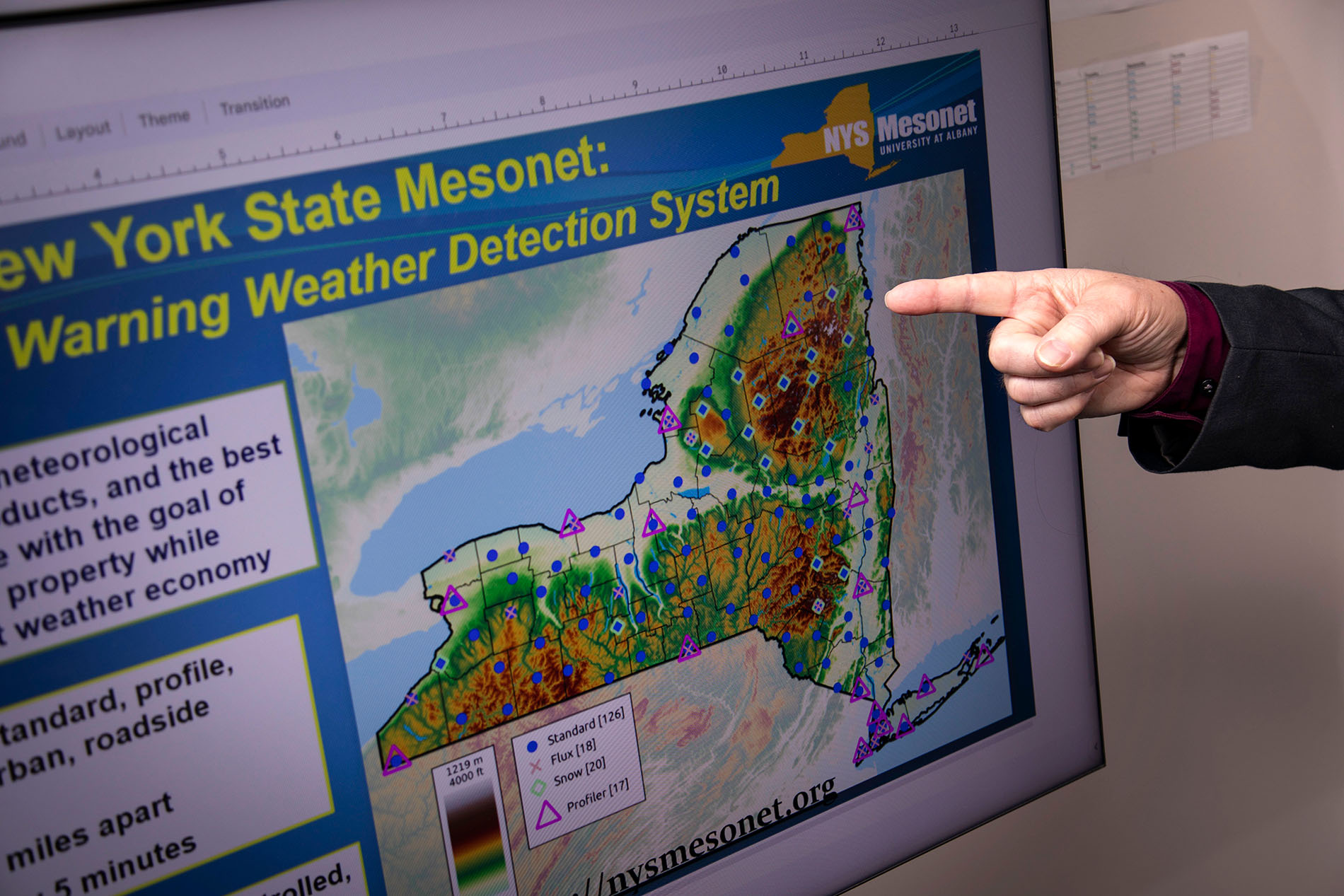UAlbany Researchers Receive $3 Million to Support Emergency Preparedness and Response to Weather Extremes

By Mike Nolan
ALBANY, N.Y. (Nov. 30, 2023) — A federal report released in September found that, between January and August of this year, the United States experienced a record-breaking 23 weather-related disasters. The weather events contributed to the deaths of 253 people and had an estimated total economic cost of $57.6 billion. The report did not include the costs associated with recent storms such as Hurricane Idalia and Tropical Storm Ophelia.
A new $3 million grant from the U.S. Department of Homeland Security (DHS) will support researchers at the University at Albany in improving emergency management and response around these increasingly frequent and severe weather events to save lives and property.
Exploitation of Mesonets for Emergency Preparedness and Response in Weather Extremes (EMPOWER) will focus on leveraging real-time data from the New York State Mesonet, a statewide weather network operated by the University at Albany, and other advanced weather observations, to create a suite of new support tools that are designed for emergency managers, first responders, and other key public and private stakeholders.
The pilot project, which is being supported through the DHS Science and Technology Directorate, will serve as a regional testbed to explore the potential of using big data to improve emergency management outcomes.
“The frequency of severe weather is increasing in association with a warming global climate. While national in impact, some states, including New York, are more susceptible to a wide variety of high-impact extreme weather events, including hurricanes, flooding, blizzards, ice storms, tornadoes, severe windstorms, severe cold and heat, and drought,” said Chris Thorncroft, who is co-leading the project and directs UAlbany’s Atmospheric Sciences Research Center, Center of Excellence in Weather and Climate Analytics and New York State Mesonet.
“The purpose of EMPOWER is to develop next-generation decision-support tools that can be used around extreme weather events. We want to equip the emergency managers today with the tools and data needed to manage the emergencies of tomorrow,” Thorncroft added.
Weather Data to Empower Emergency Managers
Following Superstorm Sandy and several other extreme weather events in New York, the Federal Emergency Management Agency (FEMA) provided the state with a recovery and resiliency grant to establish the Early Warning Severe Weather Detection Network in 2014, now known as the NYS Mesonet.
The Mesonet was completed in April 2018, with UAlbany leading the design, installation and operation. Each of its standard 127 weather stations, spaced an average of about 19 miles apart across the state, are equipped with automated sensors that measure temperature, humidity, wind speed and direction, pressure, precipitation, solar radiation, snow depth, soil information and also offer camera images every five minutes.

EMPOWER will utilize Mesonet data to create a dynamic, customizable user interface where relevant weather data will be readily available. The interface will prioritize actionable intelligence, providing emergency managers with the real-time information needed to protect life and property.
The Mesonet data will be integrated with other weather and non-weather observations, including data regarding socio-technical and environmental risks, to provide timely, tailored, localized hazard warnings, and facilitate protective action for vulnerable communities, businesses and infrastructure. For example, Hurricane Ida — and the recent flooding caused by the remnants of Ophelia — demonstrated how extreme rainfall can exceed the carrying capacity of the New York City’s sewer system and put cellar apartments and transportation systems at risk.
“The response to recent weather disasters across the country indicates that gaps still remain between potentially available weather observations and emergency response,” said Eric Stern, who is co-leading the project and is a professor and faculty chair at UAlbany’s College of Emergency Preparedness, Homeland Security and Cybersecurity. “We plan to help address these gaps, offering direct and actionable access to weather observations, including our Mesonet data, that can help leaders and emergency responders make urgent decisions to protect life and property.”
While EMPOWER proposes to use the NYS Mesonet as a proof of concept, the tools and strategies developed through the project will be designed to translate to future interfaces with existing and forthcoming mesonets across the country.
“Within the last year, a variety of new statewide mesonets have been funded or are in the midst of construction,” said Thorncroft. “This influx of new observational data presents a unique opportunity to improve situational awareness and decision making around extreme weather events.”
A Nexus of Weather, Climate and Emergency Preparedness
UAlbany’s ETEC research and development complex, where EMPOWER will be located, is home to one of the nation’s largest concentrations of atmospheric and climate researchers, many of whom are already creating smart weather-based solutions to improve resiliency.
ETEC is also home to the nation’s first College of Emergency Preparedness, Homeland Security, and Cybersecurity (CEHC), and many of the University’s dozens of faculty members who specialize in artificial intelligence.
Additional UAlbany investigators on the project include Nick Bassill of the Center of Excellence in Weather and Climate Analytics, Brandon Behlendorf, DeeDee Bennett Gayle, Doug Clifford and Amber Silver of CEHC, June Wang of the NYS Mesonet and Kara Sulia of the xCITE Lab, a data and visual analytics center connecting research with emerging technologies.




